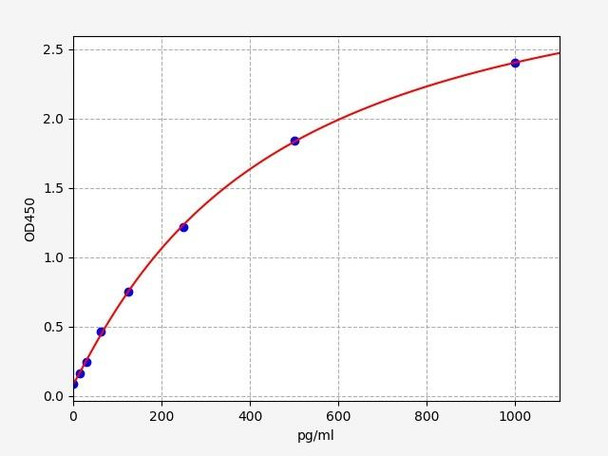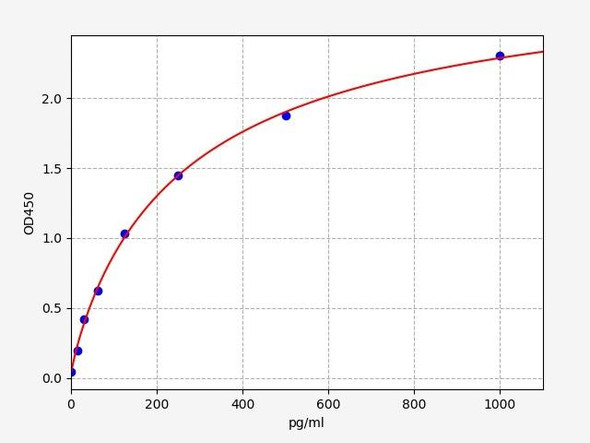Rat CGRP / Calcitonin gene-related peptide 1 ELISA Kit (RTFI00330)
- SKU:
- RTFI00330
- Product Type:
- ELISA Kit
- Size:
- 96 Assays
- Uniprot:
- P01256
- Sensitivity:
- 9.375pg/ml
- Range:
- 15.625-1000pg/ml
- ELISA Type:
- Sandwich
- Synonyms:
- Calca, CALC1, CALCA, Calcitonin 1, CGRP, CT, Katacalcin, PCT, Preprocalcitonin, ATP2B2plasma membrane calcium ATPase, ATPase, Ca++ transporting, plasma membrane 4, DKFZp686G08106, DKFZp686M088, EC 3.6.3, EC 3.6.3.8, Matrix-remodeling-associated prote
- Reactivity:
- Rat
Description
Rat CGRP/Calcitonin gene-related peptide 1 ELISA Kit
The Rat CGRP (Calcitonin Gene-Related Peptide) ELISA Kit is specifically designed for the accurate measurement of CGRP levels in rat serum, plasma, and cell culture supernatants. This kit offers high sensitivity and specificity, allowing for reliable and reproducible results that are essential for a variety of research applications.CGRP is a neuropeptide that plays a critical role in pain transmission, inflammation, and vasodilation. Its levels are often elevated in conditions such as migraines, arthritis, and neuropathic pain.
By accurately measuring CGRP levels, researchers can gain valuable insights into the mechanisms underlying these conditions and potentially identify new therapeutic targets.Overall, the Rat CGRP ELISA Kit is a valuable tool for studying the role of CGRP in various physiological and pathological processes, and its high-quality performance makes it a reliable choice for researchers in the field.
| Product Name: | Rat Calca (Calcitonin gene-related peptide 1) ELISA Kit |
| Product Code: | RTFI00330 |
| Size: | 96 Assays |
| Target: | Rat Calca |
| Alias: | Calca, CALC1, CALCA, Calcitonin 1, CGRP, CT, Katacalcin, PCT, Preprocalcitonin, ATP2B2plasma membrane calcium ATPase, ATPase, Ca++ transporting, plasma membrane 4, DKFZp686G08106, DKFZp686M088, EC 3.6.3, EC 3.6.3.8, Matrix-remodeling-associated protein 1, matrix-remodelling associated 1, MXRA1, Plasma membrane calcium ATPase isoform 4, plasma membrane calcium pump, Plasma membrane calcium pump isoform 4, plasma membrane calcium-transporting ATPase 4, PMCA4b, PMCA4PMCA4x, sarcolemmal calcium pump |
| Reactivity: | Rat |
| Detection Method: | Sandwich ELISA, Double Antibody |
| Sensitivity: | 9.375pg/ml |
| Range: | 15.625-1000pg/ml |
| Storage: | 4°C for 6 months |
| Note: | For Research Use Only |
| Recovery: | Matrices listed below were spiked with certain level of Rat Calca and the recovery rates were calculated by comparing the measured value to the expected amount of Rat Calca in samples. | ||||||||||||||||
| |||||||||||||||||
| Linearity: | The linearity of the kit was assayed by testing samples spiked with appropriate concentration of Rat Calca and their serial dilutions. The results were demonstrated by the percentage of calculated concentration to the expected. | ||||||||||||||||
| |||||||||||||||||
| Intra-Assay: | CV <8% | ||||||||||||||||
| Inter-Assay: | CV <10% |
| Uniprot: | P01256 |
| UniProt Protein Function: | CALCA iso3: Calcitonin causes a rapid but short-lived drop in the level of calcium and phosphate in blood by promoting the incorporation of those ions in the bones. Belongs to the calcitonin family. 3 isoforms of the human protein are produced by alternative splicing. |
| UniProt Protein Details: | Protein type:Secreted; Secreted, signal peptide Cellular Component: axon; cell soma; cytoplasm; cytosol; extracellular region; extracellular space; intracellular; neuron projection; nucleus; terminal button Molecular Function:calcitonin receptor binding; hormone activity; identical protein binding; neuropeptide hormone activity; protein complex binding; receptor binding Biological Process: activation of protein kinase activity; adenylate cyclase activation; aging; antibacterial humoral response; antifungal humoral response; cellular calcium ion homeostasis; cytosolic calcium ion homeostasis; defense response to Gram-negative bacterium; defense response to Gram-positive bacterium; detection of temperature stimulus involved in sensory perception of pain; elevation of cytosolic calcium ion concentration; elevation of cytosolic calcium ion concentration during G-protein signaling, coupled to IP3 second messenger (phospholipase C activating); embryo implantation; endothelial cell migration; endothelial cell proliferation; feeding behavior; G-protein coupled receptor internalization; G-protein signaling, adenylate cyclase activating pathway; inflammatory response; innate immune response; leukocyte adhesion; monocyte chemotaxis; negative regulation of blood pressure; negative regulation of bone resorption; negative regulation of neurological process; negative regulation of ossification; negative regulation of osteoclast differentiation; negative regulation of smooth muscle contraction; negative regulation of transcription, DNA-dependent; neuromuscular junction development; neuropeptide signaling pathway; positive regulation of adenylate cyclase activity; positive regulation of cAMP biosynthetic process; positive regulation of cell adhesion; positive regulation of interleukin-1 alpha production; positive regulation of interleukin-8 production; positive regulation of macrophage differentiation; positive regulation of ossification; positive regulation of vasodilation; protein amino acid phosphorylation; receptor internalization; regulation of blood pressure; regulation of heart contraction; regulation of heart rate; regulation of systemic arterial blood pressure by neurological process; response to heat; response to pain; response to yeast; vasculature development; vasodilation; vasodilation of artery during baroreceptor response to increased systemic arterial blood pressure |
| NCBI Summary: | an inhibitor of lactotroph function and a potent vasodilator [RGD, Feb 2006] |
| UniProt Code: | P01256 |
| NCBI GenInfo Identifier: | 115485 |
| NCBI Gene ID: | 24241 |
| NCBI Accession: | P01256.1 |
| UniProt Related Accession: | P01257,P01256 |
| Molecular Weight: | |
| NCBI Full Name: | Calcitonin gene-related peptide 1 |
| NCBI Synonym Full Names: | calcitonin-related polypeptide alpha |
| NCBI Official Symbol: | Calca |
| NCBI Official Synonym Symbols: | CAL6; CGRP; Cal1; Calc; RATCAL6; calcitonin |
| NCBI Protein Information: | calcitonin gene-related peptide 1 |
| UniProt Protein Name: | Calcitonin gene-related peptide 1 |
| UniProt Synonym Protein Names: | Alpha-type CGRP; Calcitonin gene-related peptide I; CGRP-I |
| UniProt Gene Name: | Calca |
| UniProt Entry Name: | CALCA_RAT |
| Step | Procedure |
| 1. | Set standard, test sample and control (zero) wells on the pre-coated plate respectively, and then, record their positions. It is recommended to measure each standard and sample in duplicate. Wash plate 2 times before adding standard, sample and control (zero) wells! |
| 2. | Aliquot 0.1ml standard solutions into the standard wells. |
| 3. | Add 0.1 ml of Sample / Standard dilution buffer into the control (zero) well. |
| 4. | Add 0.1 ml of properly diluted sample ( Human serum, plasma, tissue homogenates and other biological fluids.) into test sample wells. |
| 5. | Seal the plate with a cover and incubate at 37°C for 90 min. |
| 6. | Remove the cover and discard the plate content, clap the plate on the absorbent filter papers or other absorbent material. Do NOT let the wells completely dry at any time. Wash plate X2. |
| 7. | Add 0.1 ml of Biotin- detection antibody working solution into the above wells (standard, test sample & zero wells). Add the solution at the bottom of each well without touching the side wall. |
| 8. | Seal the plate with a cover and incubate at 37°C for 60 min. |
| 9. | Remove the cover, and wash plate 3 times with Wash buffer. Let wash buffer rest in wells for 1 min between each wash. |
| 10. | Add 0.1 ml of SABC working solution into each well, cover the plate and incubate at 37°C for 30 min. |
| 11. | Remove the cover and wash plate 5 times with Wash buffer, and each time let the wash buffer stay in the wells for 1-2 min. |
| 12. | Add 90 µL of TMB substrate into each well, cover the plate and incubate at 37°C in dark within 10-20 min. (Note: This incubation time is for reference use only, the optimal time should be determined by end user.) And the shades of blue can be seen in the first 3-4 wells (with most concentrated standard solutions), the other wells show no obvious color. |
| 13. | Add 50 µL of Stop solution into each well and mix thoroughly. The color changes into yellow immediately. |
| 14. | Read the O.D. absorbance at 450 nm in a microplate reader immediately after adding the stop solution. |
When carrying out an ELISA assay it is important to prepare your samples in order to achieve the best possible results. Below we have a list of procedures for the preparation of samples for different sample types.
| Sample Type | Protocol |
| Serum: | If using serum separator tubes, allow samples to clot for 30 minutes at room temperature. Centrifuge for 10 minutes at 1,000x g. Collect the serum fraction and assay promptly or aliquot and store the samples at -80°C. Avoid multiple freeze-thaw cycles. If serum separator tubes are not being used, allow samples to clotovernight at 2-8°C. Centrifuge for 10 minutes at 1,000x g. Removeserum and assay promptly or aliquot and store the samples at-80°C. Avoid multiple freeze-thaw cycles. |
| Plasma: | Collect plasma using EDTA or heparin as an anti-coagulant. Centrifuge samples at 4°C for 15 mins at 1000 × g within 30 mins of collection. Collect the plasma fraction and assay promptly or aliquot and store the samples at -80°C. Avoid multiple freeze-thaw cycles.Note: Over haemolysed samples are not suitable for use with this kit. |
| Urine & Cerebrospinal Fluid: | Collect the urine (mid-stream) in a sterile container, centrifuge for 20 mins at 2000-3000 rpm. Remove supernatant and assay immediately. If any precipitation is detected, repeat the centrifugation step. A similar protocol can be used for cerebrospinal fluid. |
| Cell Culture Supernatant: | Collect the cell culture media by pipette, followed by centrifugation at 4°C for 20 mins at 1500 rpm. Collect the clear supernatant and assay immediately. |
| Cell Lysates: | Solubilize cells in lysis buffer and allow to sit on ice for 30 minutes. Centrifuge tubes at 14,000 x g for 5 minutes to remove insoluble material. Aliquot the supernatant into a new tube and discard the remaining whole cell extract. Quantify total protein concentration using a total protein assay. Assay immediately or aliquot and store at ≤ -20°C. |
| Tissue Homogenates: | The preparation of tissue homogenates will vary depending upon tissue type. Rinse tissue with 1X PBS to remove excess blood & homogenizein 20ml of 1X PBS (including protease inhibitors) and store overnight at ≤ -20°C. Two freeze-thaw cycles are required to break the cell membranes. To further disrupt the cell membranes you can sonicate the samples. Centrifuge homogenates for 5 mins at 5000xg. Remove the supernatant and assay immediately or aliquot and store at -20°C or-80°C. |
| Tissue Lysates: | Rinse tissue with PBS, cut into 1-2 mm pieces, and homogenize with a tissue homogenizer in PBS. Add an equal volume of RIPA buffer containing protease inhibitors and lyse tissues at room temperature for 30 minutes with gentle agitation. Centrifuge to remove debris. Quantify total protein concentration using a total protein assay. Assay immediately or aliquot and store at ≤ -20 °C. |
| Breast Milk: | Collect milk samples and centrifuge at 10,000 x g for 60 min at 4°C. Aliquot the supernatant and assay. For long term use, store samples at -80°C. Minimize freeze/thaw cycles. |






